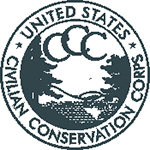History of Trough Creek State Park
The Appalachian Mountains blocked the movement of settlers from the east, delaying the settlement of the Great Trough Creek Gorge until Nicholas Crum traveled northeast from Baltimore in 1785.
Crum harnessed the power of the creek with a turbine gristmill to grind grain. George Knoblough followed and in 1789 built a short-lived bloomery to smelt iron.
Attracted by the gorge’s natural resources of iron ore, limestone, trees, and water power, Reuben Trexler, an ironmaster from Berks County, Pennsylvania, constructed a bloomery in 1818.
Trexler partnered with his father-in-law Jacob Lesher, another Berks County ironmaster, to build Trough Creek Furnace, which produced far more pig iron than the bloomery.
Charcoal fueled the furnace, requiring an acre a day of trees to produce the charcoal required.
John Savage, of Philadelphia, leased the furnace in 1832, renaming it Mary Ann Furnace, and built Savage Forge to process the pig iron into bar iron.
William Firmstone, an Englishman with knowledge of European iron making techniques, managed the furnace.
During 1835, for the first time in the United States, good iron was produced using coke as at fuel at Mary Ann Furnace.
The process lasted for one month, then ceased, likely due to the lack of coke or the high cost. Mary Ann Furnace continued smelting iron with charcoal until the 1850s or 1860s.
The demand for iron created by the American Civil War led Horatio Trexler, son of Reuben, to rename the furnace Paradise Furnace and return it to blast in 1865.
The end of the Civil War and the resultant economic downturn led to Paradise Furnace going out of blast for the final time 1869.
During 1913, the railroad incorporated as the Juniata and Southern Railroad and extended the rail line seven miles to reach the Broad Top Coal and Mineral Company’s mine at Jacobs, Pennsylvania.
During 1917, the mine closed and the timber was depleted. The railroad was dismantled and scrapped.
Due to the need for metal for World War I, the scrap sold for more than the original cost to build the railroad.
With the loss of its trees, the land was prone to floods and forest fires.
Civilian Conservation Corps

During 1933, to relieve the rampant unemployment of the Great Depression, President Roosevelt created the Civilian Conservation Corps (CCC).
The young men in the CCC received food, clothes, and a small paycheck in return for building roads, trails, and recreational facilities; fighting forest fires; planting trees; and doing many other conservation activities.
During June of 1933, Company 1331 arrived and lived in tents while they built Camp S-57, named Camp Paradise Furnace.
The young men planted trees, constructed roads and trails, and created Trough Creek State Park, which opened in 1936.
World War II ended the CCC and Camp S-57 closed in 1941.